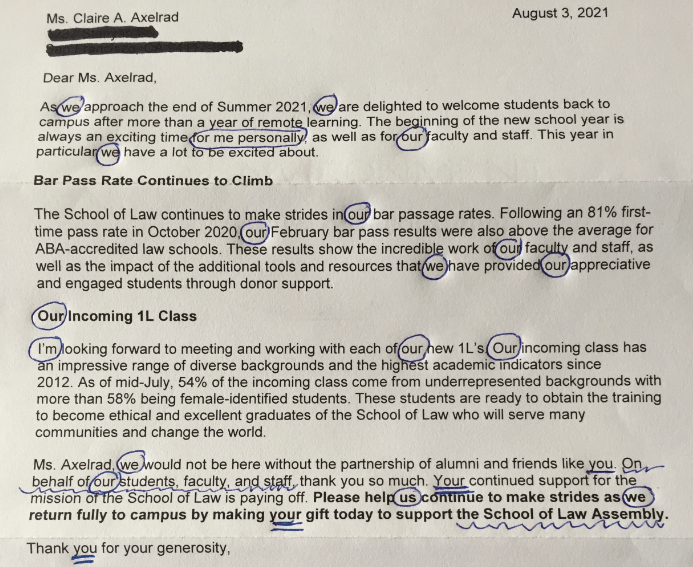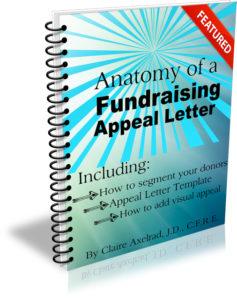 I never begin writing a fundraising appeal without beginning with a template and checklist. It’s always good to remind yourself of the fundamentals.
I never begin writing a fundraising appeal without beginning with a template and checklist. It’s always good to remind yourself of the fundamentals.
1. YOU
“The most beautiful thing in the world is you.”
— Alvin Ailey, choreographer and dancer, (1931-1989)
This gets to who you’re writing to. Not to yourself, program staff. or board of directors. You’re writing to ONE donor. It’s about their ego, not yours. Their needs, not yours.
Take a good hard look at your letter. How often do you use “I,” “my,” “our,” “we,” or the name of your organization vs. “you” and “your?”
Fix this! Here’s a “you test” you can use from Bloomerang.
Here’s a “don’t” example:

As you can see, the ratio of ego-centric to donor-centric pronouns is an astonishing to 18:3. The donor doesn’t even appear in the letter until the last paragraph! That’s like getting 17 out of 100 on a test – with 50 out of 100 being an “F” grade. This gets a “Z” – for zero on the donor-centricity scale.
2. EASY
“Easy reading is damn hard writing.”
— Nathaniel Hawthorne
People are strapped for time; attention spans are short. If you make folk work too hard to grasp your narrative, they’ll simply give up. Keep readability at the forefront.
Begin with the Flesch-Kincaid grade level test.
Copywriting experts like Tom Ahern and Jeff Brooks counsel keeping prose at the 4th – 8th grade level. For most charities, I’m good at the happy medium of 6th grade. Don’t worry about “talking down” to donors; your job is merely making your appeal easy to consume.
Write colloquially (i.e., how you would talk).
Read your letter out loud; take out anything over which your tongue trips. It’s okay to use contractions and one-word sentences, and to begin sentences with conjunctions. That’s what we do when we talk. And a good fundraising appeal should be a one-to-one conversation on paper.
Make your prose to flow.
This means using indents (which give readers’ eyes a rest), headlines, sub-heads, boldface, underlines, bullets and italics to call out important points for skimmers. It also means using compelling images, since a photo is truly worth 1,000 words (yet no one has time to read all those words). Photos with captions are particularly magic.
Help readers find your most important points.
This is why understanding eye movement studies showing where people’s eyes tend to move across a page is important. People look at the salutation, the top right corner (good place for a photo), the signature and the P.S. first. Then they look at headlines and sub-heads. In an email they’ll look at the subject line, preview pane and sender. Make sure all these valuable pieces of real estate are used and optimized. Then check to make sure your most important points – like the ask! – aren’t buried places your reader may never see (e.g., the top third of the second page; the third or fourth paragraph).
Let’s stick with the Law School Letter example above, which besides the you-centered failure is also a slog to read:
- Paragraphs are not indented so the text is blockish and uninviting.
- There are only two headlines which, if read alone, give the following message: Bar pass rate continues to climb. Our Incoming 1L class.” Hmmn… not particularly compelling as a fundraising appeal.
- There is nothing else to break up the text or draw attention to important points.
- There are no images to tell a story explaining why they’re sending this appeal.
Most important, make it easy for readers to donate.
If it’s a piece of direct mail, the response device should stand alone in making a strong case for support. It should also include a phone number and website URL (maybe even a QR code), should the reader want to make a gift other than by check. If it’s an email, the donation landing page form should be compelling, brief and easy to complete. Don’t include information fields you don’t need, as this may cause your prospective donor to “abandon cart.” Ask those questions later, perhaps on your thank you landing page or in a mailed post-gift survey.
3. WELCOME
“True donor centricity would require organizations to look to the wellbeing and growth of their supporters. It would also require nonprofits to develop supporter journeys that are respectful of “where donors are” in their understating of the cause and thus employ appropriate messaging to allow individuals to learn and develop.“
Does your letter welcome the reader to continuing being involved with your cause (let alone continuing to read the letter)? When you welcome supporters into your family and community it is incumbent on you to include information in your appeal that deepens their understanding of current issues as they present themselves. This practice encourages people to continue on a journey with you, becoming increasingly loyal over time.
When you make your appeal all about a single transaction, rather than placing your work within a transformational context, you’re less likely to connect on a deeply personal level. “Welcome to this very vague group which may or may not enact values you care about, because we’re just guessing what those values may be” doesn’t really cut it.
Let’s revisit the Law School Letter example above, which profoundly fails this test:
- Rather than engaging and welcoming the donor, the letter tells readers the Dean is welcoming students back to campus. The emphasis is placed on the school community, rather than the alumni community. Students are welcomed; alumni are hit up.
- The letter then assumes the reader cares about the school’s current bar passage rates, without having any knowledge whether this matters to the reader. (It didn’t matter to me.) This does not respect where the prospective donor is in their journey vis a vis the school.
- The letter next assumes the reader cares about the demographic make-up of the entering class – perhaps because diversity is a “buzz issue” in the news? But since it doesn’t explain why this should be important to me, it leaves me pretty cold.
- Finally, the letter encourages me to continue “support for the generic mission of the School of Law” – without giving me a clue what that mission is today. (I graduated quite some time ago, and don’t have a clue.)
4. HEART AWAKENING
“Nothing glows brighter than the heart awakened to the unseen light of love that lives within it.”
— Guy Finley, philosopher, author and musician
More philanthropy comes from the heart than the head. Our rational selves are slow to act, especially if we fear we have something to lose (money?). That’s why you want to make your appeal more about love than money. When we’re talking about love, we’re talking about the heart. You want your appeal reader to experience something awe-inspiring and bigger than themselves. Something that stirs their emotions. And for bonus points, since Nobel Prize winner Daniel Kahnemann proved fear of loss weighs heavier than hope of gain, you want to show your prospective donor what they stand to lose if they choose not to give.
Let’s see how the Law School Letter example fares on this test:
- There’s no clue what will be lost if the reader doesn’t give. It appears the incoming class looks swell, bar pass rates are good, and… nothing really wrong with this picture. (My heart is not awakened).
- There’s nothing awe-inspiring to love. This appeal isn’t really about love or There’s no mention of an amount that needs to be raised (let alone for what heart-awakening purpose). There’s no specific ask amount.
In Part 2 we’ll look at four more appeal writing fundamentals.
Want to learn more about effective fundraising appeal writing?
 Grab my Anatomy of a Fundraising Appeal + Sample Template. This is a simple, yet incredibly thorough, 62-page step-by-step guide to crafting a killer appeal letter or email appeal. It’s not just a breezy 2-page form, like what you’ll find elsewhere. Because writing a compelling fundraising letter can be tricky. It’s not the same kind of writing as a brochure, annual report or grant proposal. But it’s not rocket science – it’s something you can easily learn. It’s just not something most of us are taught. And that’s where this nifty e-Guide comes in!
Grab my Anatomy of a Fundraising Appeal + Sample Template. This is a simple, yet incredibly thorough, 62-page step-by-step guide to crafting a killer appeal letter or email appeal. It’s not just a breezy 2-page form, like what you’ll find elsewhere. Because writing a compelling fundraising letter can be tricky. It’s not the same kind of writing as a brochure, annual report or grant proposal. But it’s not rocket science – it’s something you can easily learn. It’s just not something most of us are taught. And that’s where this nifty e-Guide comes in!
Not satisfied for any reason? No worries. You have my no-questions-asked, 30-day, 100% refund guarantee. Now… onward and upward to fundraising appeal success!
Note: I’m a straight shooter and call things as I see them. I never have intention to shame any charity, merely to point out examples – Do’s and Don’ts – to help the broader social benefit sector. If you happen to work for the organization that wrote this letter, and would like a complimentary coaching session, please don’t hesitate to reach out. Maybe you’ll tell me it raised a ton of money, which I would be happy (albeit curious) to hear. Fundraising, like anything else worth doing, is a process of continuous learning. Thank you.
Photo by Glenn Carstens-Peters on Unsplash






There are a lot of valuable pieces of information here – although I understand how this would really generate a lot of money (donor centric fundraising that strokes the supporters ego) is it really transformational? Actually let’s not speak in absolutes – let’s ask ourselves does this promote transformation or does it merely stroke egos. I invite people to consider centering the community in fundraising letters, because that’s what we’re doing this for. In the law school ask, the one aspect I don’t think they failed in was using “we” rather than “you” – it showed the reader that they are not the focus and should not be the focus, the money is being raised for a community they care about, may be apart of, or was apart of at some point in time. The sustainability in philanthropy and ultimately decolonizing wealth, is shifting the donors focus from themselves to the crux of why we do this work – the community, the whole, something larger than one individual. The only power that donors should have is being able to amplify the voices of those they’re trying to help, the power shouldn’t be in the hands of those who aren’t impacted and don’t have first hand knowledge of what it’s like to live life in another’s skin / in another country / having a different reproductive system. I personally believe we need to stop patronizing impacted communities with savior-esque approaches to philanthropy.
That being said I took a lot of valuable structure based tips from this article that were extremely helpful and improved my appeal writing. I just wanted to point out that some of these tips are a bit outdated in terms of fostering diversity, equity, and inclusion (I noticed you named diversity as a buzz word, curious what you think about DEI policies and lenses…. If you don’t support them, philanthropy is not for you).
Like I said – donor centricity is profitable – but is it sustainable? No.
I take your point Adina. You may be interested in this more recent article I wrote: https://clairification.com/2023/09/14/effective-philanthropy-facilitation-recipe-love-meaning-empathy-cooperation-attention-interaction/. ANd, perhaps, this one on making progress: https://clairification.com/2023/08/21/progress-is-transformational-when-you-arrive-you-feel-good/. I also comment on the “donor as savior vs. empowerer” issue on this panel: https://clairification.com/the_power_of_storytelling_for_nonprofits/. Thanks so much for reading and joining the dialogue.